Decorative stone in the interior of the hallway
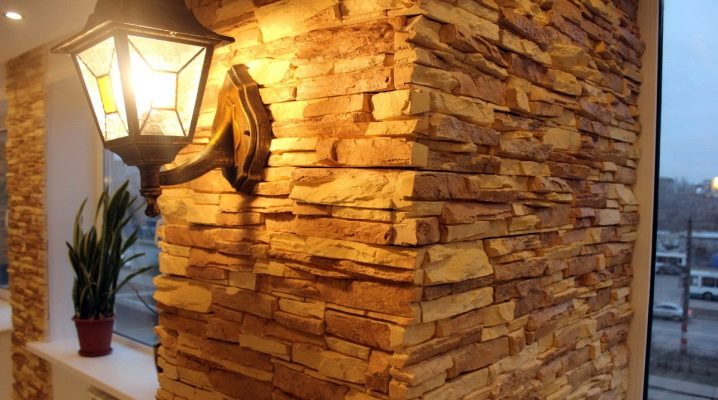
If you dream of getting an elegant designer interior as a result of repairing the hallway, which looks solid and expensive at the same time, it is worth using decorative stone in the interior decoration of the hallway. Humanity has been familiar with this finishing material since antiquity, and the modern decorative stone in the hallway is associated with monumentality, security and tranquility.
The nobleness of the room will be added by its massive character, and the variety of embossed surfaces and a rich palette of color shades will add respectability and luxury to the interior.
In the hallway, the decoration of which includes decorative stone, the atmosphere of personal safe comfort will always reign, although at first glance this material is endowed with heaviness and natural coldness.
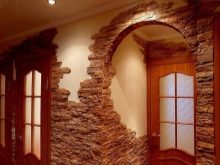
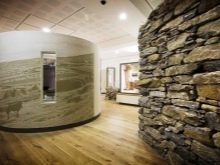
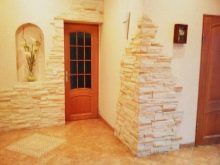
Advantages and disadvantages
The artificial stone surface has a lot of positive qualities:
- Respectable appearance. The brutality and natural texture of the stone is one of the main reasons why this type of material is often preferred. True romantics, dreaming in their youth of the Middle Ages and the harsh castles of Gothic architecture, can make their dream come true at home.
The use of decorative stone in the design of the hallway will make the interior original and stylish, emphasize the individuality of its owner.
- Light weight. Wealthy citizens - owners of large corridors of houses - appreciate naturalness in everything, they can afford to decorate the hallway in real stone. But this finishing option is heavy, which requires additional surface reinforcement. The alternative here is a decorative stone, it provides only a thin layer of material and weighs relatively little compared to the natural "colleague". And it is almost impossible to distinguish it from the real one, it can imitate even the rarest breeds.
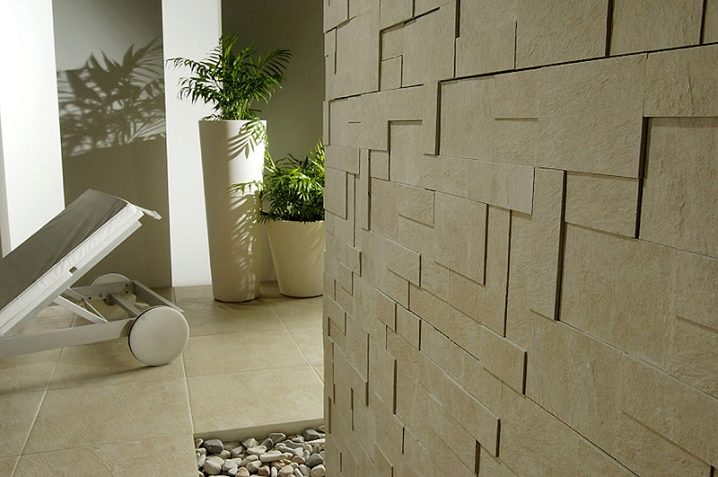
- Simple installation. Manufacturers of artificial stone take into account the fact that it will be used for wall decoration, at the initial stage it is already adapted for this process. It does not require a perfectly flat laying surface; there is no need to use a level. An easy-to-use material is attached to glue or ordinary cement mortar, cracks do not interfere with it - such imperfections are quickly eliminated with the same mortar or are hidden by a piece of stone of a suitable size.
- Fire resistance. The material is non-flammable, which increases the safety of the room and adds a plus to the advantages of stone finishing over other types.
- Durability. After finishing the corridor with artificial stone once, you can forget about repairing its surfaces for a long time. The service life of stone decor with proper installation and careful maintenance reaches 12-15 years.

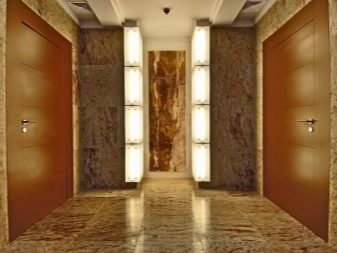
- Affordable price category. The cost of artificial materials is significantly lower than that of natural stone. This allows it to be used on large areas, since the total amount spent on the purchase of materials and finishing work is more affordable for the average consumer than in the case of real samples.
- Compatibility. Any stylistic solutions allow you to use decorative stone for your interior and combine it with other types of finishes: wood, metal, brick, glass, plaster.
- Easy to care for. Such a coating does not require special attention when cleaning. It can be periodically vacuumed and wiped with a cloth using gentle cleaning agents.
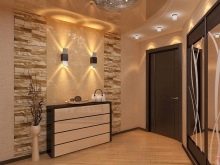
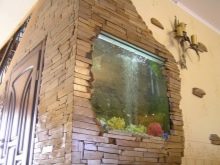
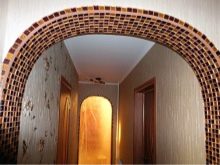
The stone has much less disadvantages than advantages.
Compared to natural materials, artificial turf is more susceptible to sunlight and moisture.
For additional protection, it is necessary to treat it with special hydrophobic compounds.

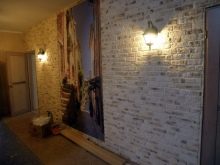
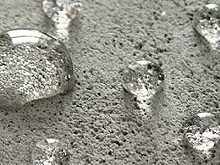
Views
Thanks to modern industrial developments, several options for decorative finishes are distinguished.
Flexible stone
Flexible stone is a relatively new material created thanks to innovative technologies. It is a cut of sandstone, combined with a textile base made of polymers, which allows you to thoroughly convey the structure of natural stone.
Designers and architects value high-tech material for its unique properties, such as pliability, lightness, naturalness, durability, easy installation, a wide range of textures and colors. The disadvantages of flexible finishing include the high cost, which is fully justified by the use of cuts of natural rocks.
The inherent relief of the stone can make cleaning somewhat difficult, and dust accumulating in the folds of the coating will become a source of allergic reactions for people prone to this disease.

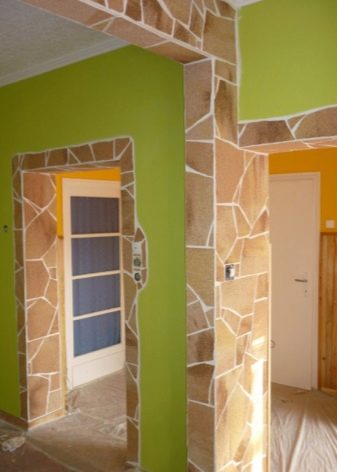
Wild stone
Wild stone is a popular type of decoration that looks impressive in any interior due to its naturalness and closeness to nature. Since ancient times, noble people have used natural material to decorate their palaces and castles, and today the use of wild stone in interior decoration speaks of the high status and financial situation of its owner.
Formed over many millennia in the natural environment, the type of coating has a rich color gamut and allows you to bring any design ideas to life.
In processing plants, large stone slabs are split into many small pieces to create a unique facing material. Even in a huge pile of pebbles, it will not be possible to find two identical ones, which speaks of the unique texture of the decorative finish.
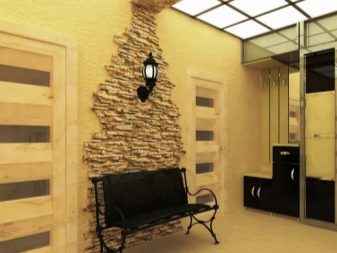

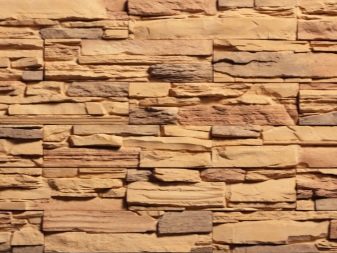
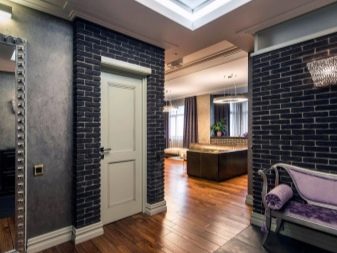
Fake diamond
Artificial stone is specially made industrially, less often by hand. In production, a special solution is poured into molds and dried, heat treated, coated with impregnations or glaze. Concrete, quartz, acrylic, gypsum, porcelain stoneware are used as raw materials for the artificial material. The composition includes dyes, plasticizers, reinforcing elements. All components are safe for human health.
Masonry made of artificial material is easy to put in order, if any element is damaged, it is easy to replace.

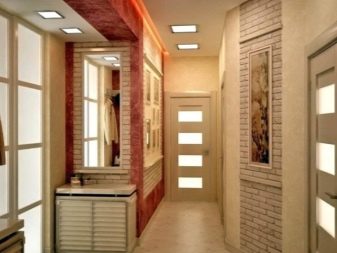
Materials (edit)
The production of decorative stone finishing uses a variety of raw materials.
Gypsum stone
Gypsum is increasingly used for interior decoration due to its excellent performance properties. The material can be made independently, having a plaster base and special forms on hand. The small proportion of finished products is the best suited for cladding thin interior partitions and art structures that cannot be subjected to additional loads. Gypsum allows you to create a variety of architectural forms, for which it is appreciated by designers all over the world.
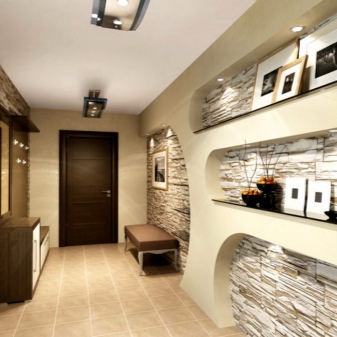
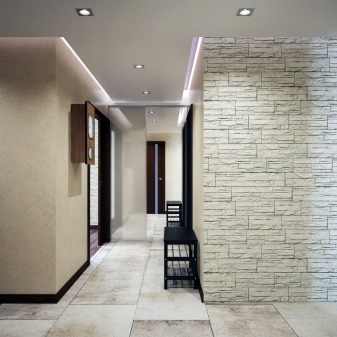
Among the positive qualities of the material are a low price category and environmental friendliness. Plaster finishing will cost significantly less than in granite or marble, this is an excellent opportunity to save money on renovation work.And the ability of the finished cladding to allow air to pass through will provide a favorable microclimate in the room. The disadvantages include the fragility of products: they require careful handling and compliance with the rules of transportation.

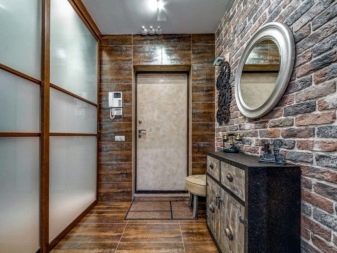
Decorative stone from egg trays
Decorative stone from egg trays in the hallway decoration is an unexpected design solution. This is the most budgetary and simple version of wall cladding that even a child can cope with, but the final appearance does not lose at all from this - the decorative masonry looks spectacular and does not differ much from industrial material.
For the manufacture of "bricks" must be available cardboard, egg cells and PVA glue. The cells are torn at the folds, leaving more relief, and glued to the prepared sheets of cardboard. To give the desired texture, an additional layer of paper napkins is applied on top. The finished products are dried and covered with a layer of paint, at the end they are varnished. This brickwork from egg trays will be an excellent decoration for the hallway.
This brickwork from egg trays will be an excellent decoration for the hallway.
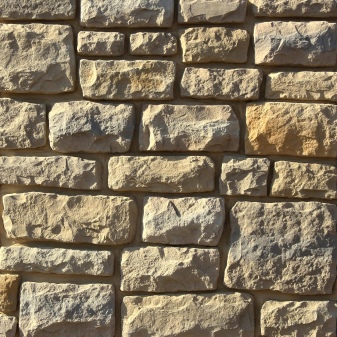
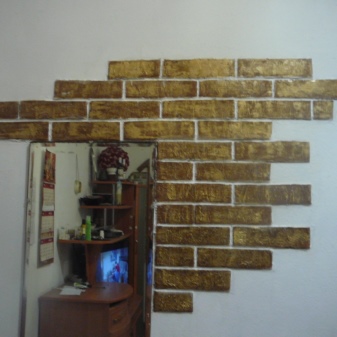
Dimensions and texture
Decorative stone is distinguished by its shape and texture:
- Rubble - smooth, rounded, imitating boulders or pebbles.
- Chipped - have characteristic chips and irregularities, similar to untreated rock.
- Sawed - obtained as a result of sawing large blocks into plates; all sides of such products, except for the front, undergo a grinding procedure.
- Mosaic - all elements are combined in color for a specific pattern.
- Brick - allow you to simulate brickwork in various modifications.
- Tiled - create a semblance of tiled masonry on the surface, polish the front side.
- Fantasy - they create images of stones that do not exist in nature, the shapes and colors of which are selected for the desired design.

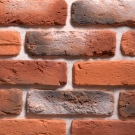
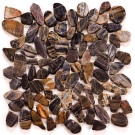
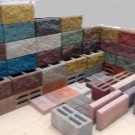
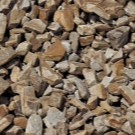
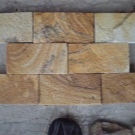
If the hallway space is not large enough, it is better to refuse to use decorative products of different texture. It is appropriate to choose one option, or include materials that are similar in shade.
Decorative stones of different sizes, but the same color, allow you to create original compositions and successfully zone the space. In this case, doorways and visible corners are faced with large details, and small fragments are used for active zones.
After the future design of the corridor has been selected, it is required to calculate the amount of material.
In the case of decorative items, this is not difficult: they most often have the correct geometric shape.
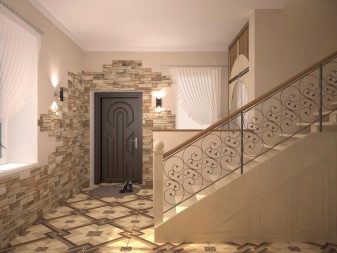
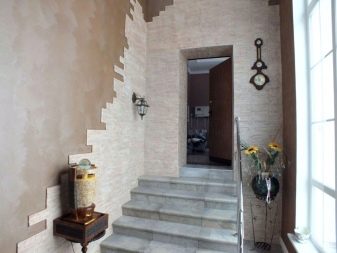
Colors
Facing a hallway with a decorative stone can be both an excellent design solution and a waste of money - it all depends on the thoughtfulness of the future project.
The color range of the products plays an important role here. The typical layout of modern apartments does not imply the presence of windows in the hallways; they have to be content with artificial lighting. The optimal solution would be to choose decorative stones of light shades, which are specially targeted by artificial light sources.
The color of the stone cladding should not be too different from the rest of the finish, otherwise it will cause dissonance in the interior. It is enough if it is slightly darker than the general tone of the walls.
The hallway and the corridor are premises in which functionality is in the first place. They should not be too bright, pastel-colored walls and a neutral textured stone are appropriate.
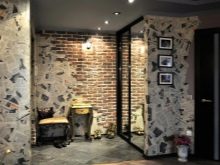
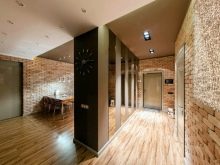
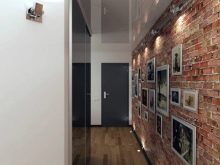
White shades
White color in the decoration visually enlarges the room, which is especially important for small hallways. The snow-white design will make the room refined and luxurious, giving it solemnity. Such an interior is considered a classic of the genre, true connoisseurs often choose it, realizing how well it will fit into the overall space. It is believed that this shade is the most easily soiled for facing the corridor, but this opinion is erroneous.
Stone is a very practical material that is easy to clean.

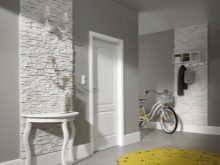
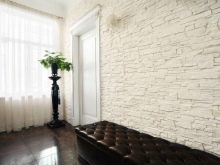
You should not completely "dress" the interior in this color, such an official style will resemble a hospital. To dilute the background, you can add contrasting accessories: bright red lamps or a zebra-colored carpet will bring dynamics to the design of the corridor, giving it individuality.
White walls are an indispensable attribute of the Greek Mediterranean style.
To embody it at home, it is enough to add shades from the spectrum of blue and blue.
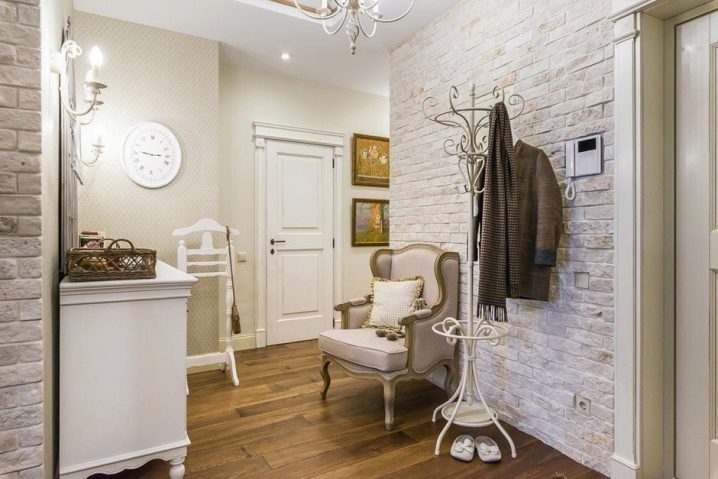
Gray tones
The austere gray color represents intelligence and noble origins. The entrance hall in gray stone says that its owner is a practical and business person who does not like to deviate from his principles. Such a cladding is perfectly combined with other spectra, the room will never have a faceless oppressive atmosphere. Lovers of medieval Gothic can complement the gray masonry interior with red and black accessories.
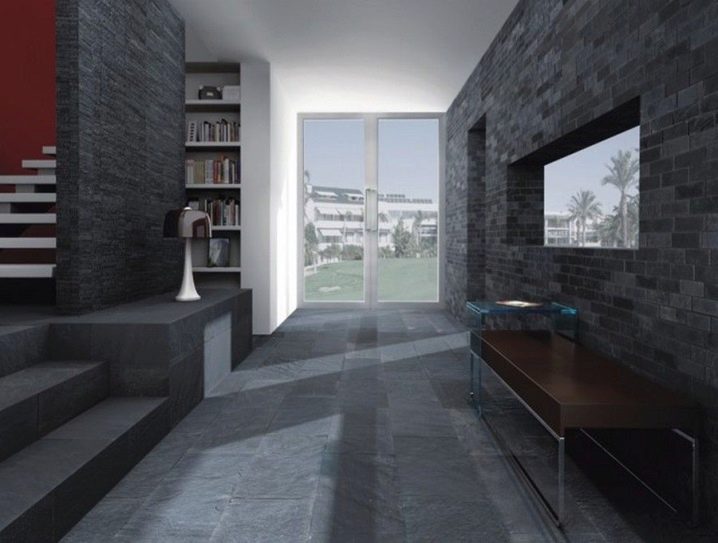
Beige and brown tones
The beige and brown palette in the hallway is one of the most popular. Warm tones help create a favorable atmosphere, tune in a positive mood. In such an environment, it is cozy and comfortable for both the owners of the house and the guests.
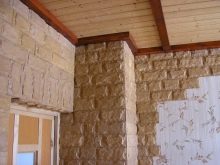
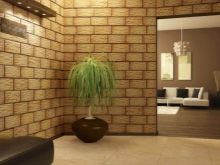
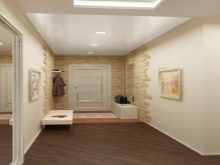
Design options
Do not make completely stone walls in the hallway, this will turn a small room without windows into a cave or dungeon.
Fragmented cladding will look more laconic, with its help you can emphasize the necessary accents.
- Wall decor in the corners of the hallway. Masonry in the inner or outer corners of the room is one of the favorite techniques of decorators, it creates the effect of ancient ruins and allows you to zone the room.
- An extravagant solution is to lay the floor in stone. Financially wealthy citizens can easily afford such a floor covering. The problem lies in the fragility of the artificial material, which is subjected to mechanical stress during operation. For decoration, it is better to use natural products.
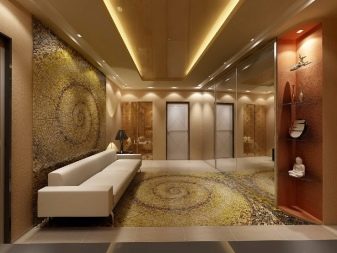

- Hollows or niches in the hallway can be effectively beaten with the help of a stone, and in order for the texture of the material to "open up", it is necessary to direct sources of artificial light into the openings.
- Decorative stone allows not only to decorate the walls, but also to emphasize the doorway. The most popular option is a stone arch, it will always be in the spotlight. For some it is an element of the Middle Ages, for some it will remind the entrance to a mysterious cave or grotto, while others will have associations with the Arc de Triomphe.

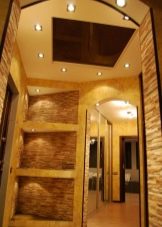
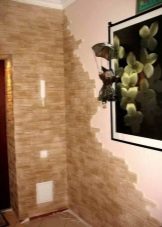
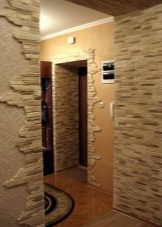
What can you combine with?
Decorative stone gets along well with all types of plaster, decorative putty, paint and wallpaper.
- Cladding with plaster. Artificial stone and decorative plaster are a good combination when decorating rooms. Quality, durability and nobility are the defining features of the proposed decor. For a harmonious combination of materials, it is worth resorting to classic transitions: stone corners flowing smoothly into a plastered wall, framing arches, accents of niches and windows. Single inclusions of "stone" look unusual, as if appeared due to peeling plaster.
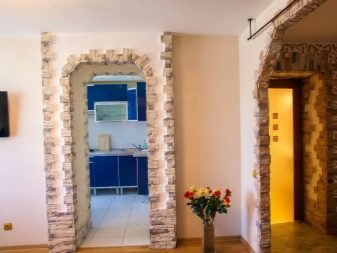
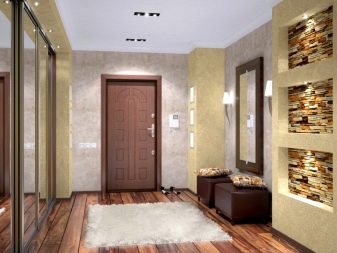
- With wallpaper. The tandem of stone and wallpaper is one of the most popular in modern apartments due to the wide range of these materials. In order to concisely connect them in one interior, it is better to use tapestries of light muted tones. Stone cladding should not be combined with wallpaper with a pattern; a light floral ornament would be more appropriate. The emphasis in the room should be on the stone, and the large drawing and geometric patterns on the trellises will overwhelm the hallway space, and the excessive texture of the material adjacent to the stone will be inappropriate.
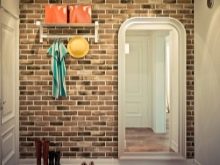
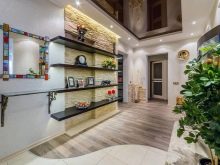
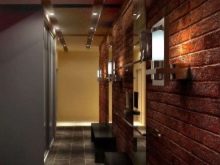
What can be replaced?
It is not always possible to use decorative stone finishes; modern development technologies make it possible to solve this problem with the help of available analogs.
- Decorate with panels indoors. This is the best option when you need to quickly and efficiently transform the hallway with minimal costs for installation work and materials. Panels made from natural or artificial raw materials are easily installed on the surface of walls and ceilings, successfully harmonize with other finishing materials and have an aesthetic appearance.
- Laying with tiles. Such interchangeability is often found in modern interiors due to the practicality and rather low cost of the material. Decorative tiles will cost several times cheaper, and they look no less attractive even in comparison with natural stone. A good professional does not immediately determine whether the tile in front of him or a natural sample.
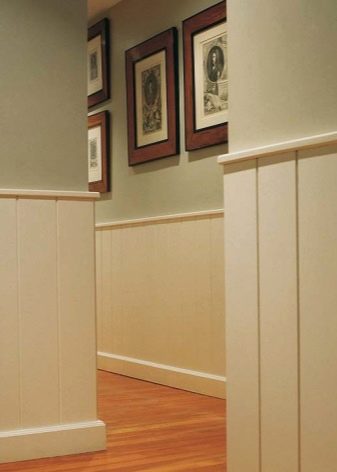
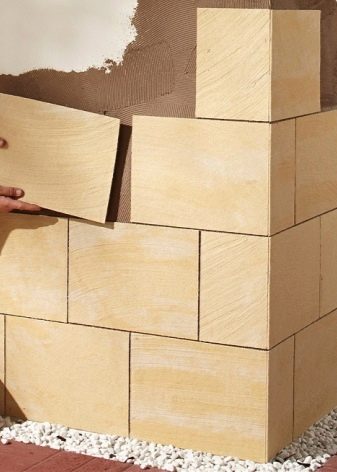
Beautiful examples of interior design
A small stone entrance hallway in an apartment requires moderate use of this material. Solid masonry or large sizes of decorative items will add weight to the room, it will be uncomfortable to be in it.
A small splash of stone on one of the walls, free of doorways, will look spectacular and stylish. For example, an imitation of a stone rack, in which decorative shelves are attached to the wall, and the background for them is a masonry made of artificial stone. The beige color of the plastered wall and the terracotta "brick" organically complement each other. Silhouettes of bamboo stalks and general minimalism of the design give the interior a Japanese style, lightness and serenity.

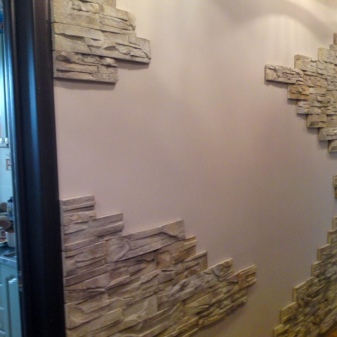
In the spacious corridor of a large house, you can fulfill an old childhood dream - to paint on the walls. With the help of decorative stones of various shapes, textures and shades, you can put any drawing on the wall, be it a beautiful landscape overlooking the river, or a portrait of your beloved cat. The versatility of the material gives a wide scope for imagination.
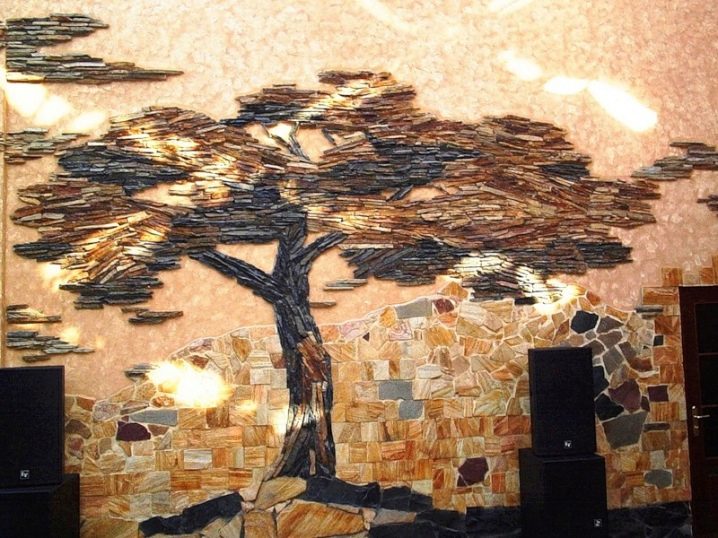
You will learn more about how to use decorative stone in the interior of the hallway in the following video.













The comment was sent successfully.